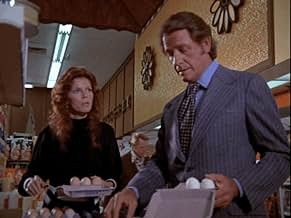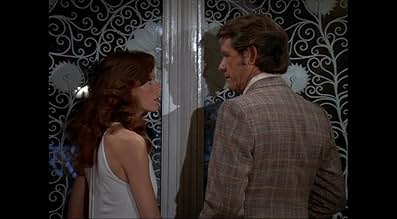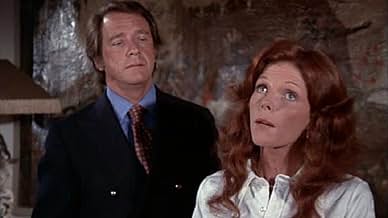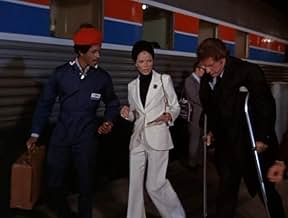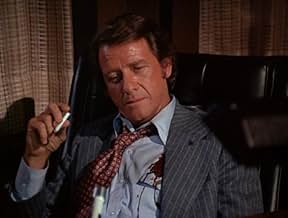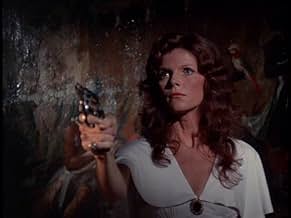Adicionar um enredo no seu idiomaA scheming wife lures an insurance investigator into helping murder her husband and then declare it an accident. The investigator's boss, not knowing his man is involved in it, suspects murd... Ler tudoA scheming wife lures an insurance investigator into helping murder her husband and then declare it an accident. The investigator's boss, not knowing his man is involved in it, suspects murder and sets out to prove it.A scheming wife lures an insurance investigator into helping murder her husband and then declare it an accident. The investigator's boss, not knowing his man is involved in it, suspects murder and sets out to prove it.
- Direção
- Roteiristas
- Artistas
Arnold F. Turner
- Redcap
- (as Arnold Turner)
Rand Brooks
- Conductor
- (não creditado)
Tom Curtis
- Charlie
- (não creditado)
John Furlong
- George
- (não creditado)
Avaliações em destaque
This 1973 remake of the classic 1944 Billy Wilder film, "Double Indemnity," is a textbook example of how to destroy a great script. This grade-B TV fodder also illustrates the folly of remakes in general. While Hollywood has gone after greedy executives that colorize black-and-white films and sought disclaimers on wide-screen movies that are shown in pan-and-scan versions, the industry has ignored the hacks that insist on taking a classic film and diminishing it with a shoddy remake.
The first step in producing a bowdlerized version of a classic is to edit the script. The Billy-Wilder-Raymond-Chandler work was cut by a half hour to fit the finished film into a specified time-slot with room for commercials. Then update the production with bland, color photography, smart, upscale sets, and TV-familiar actors. Thus, the brand-new "Double Indemnity" eliminates the atmospheric black-and-white film-noir cinematography that enhanced the mood and characterizations of the original. Gone are the dusty, shadowy, claustrophobic sets that explained the protagonists' desires to escape their situations at whatever cost. Gone are the close bond between Keyes and Neff and the erotic attraction between Neff and Phyllis.
The look of Jack Smight's take on "Double Indemnity" is more "Dynasty" than film noir. Phyllis Dietrickson has a designer home to die for, and Neff's comfy pad would be hard to afford on an insurance salesman's salary, not to mention the sporty Mercedes convertible that he drives. Neither character has any apparent motive to murder for a paltry $200,000. If not money, then perhaps murder for love or lust? Not in this version. Richard Crenna shows little interest in Samantha Eggar, and their kisses are about as lusty as those between a brother and a sister. Crenna fails to capture the cynicism of Neff, and his attempts at double-entendre and sexual suggestiveness fall horribly flat. Eggar is little better and lacks sensuality and the depth to suggest the inner workings of a supposedly devious and manipulative mind. Only Lee J. Cobb manages a creditable performance as Keyes. Director Jack Smight and his three principals have all done much better work.
There was no conceivable reason to produce this wretched remake except to fill time in a broadcast schedule. There was no conceivable reason to resurrect this dud on DVD and package it with the original film except to fill out a double-disc package. The only lesson that can be learned from this misfire is that even a great script and great dialog can be ruined with poor casting, lackluster direction, and TV grade production values. The 1973 "Double Indemnity" should be titled "10% Indemnity," because viewing it only underscores the 100% perfection of the original movie.
The first step in producing a bowdlerized version of a classic is to edit the script. The Billy-Wilder-Raymond-Chandler work was cut by a half hour to fit the finished film into a specified time-slot with room for commercials. Then update the production with bland, color photography, smart, upscale sets, and TV-familiar actors. Thus, the brand-new "Double Indemnity" eliminates the atmospheric black-and-white film-noir cinematography that enhanced the mood and characterizations of the original. Gone are the dusty, shadowy, claustrophobic sets that explained the protagonists' desires to escape their situations at whatever cost. Gone are the close bond between Keyes and Neff and the erotic attraction between Neff and Phyllis.
The look of Jack Smight's take on "Double Indemnity" is more "Dynasty" than film noir. Phyllis Dietrickson has a designer home to die for, and Neff's comfy pad would be hard to afford on an insurance salesman's salary, not to mention the sporty Mercedes convertible that he drives. Neither character has any apparent motive to murder for a paltry $200,000. If not money, then perhaps murder for love or lust? Not in this version. Richard Crenna shows little interest in Samantha Eggar, and their kisses are about as lusty as those between a brother and a sister. Crenna fails to capture the cynicism of Neff, and his attempts at double-entendre and sexual suggestiveness fall horribly flat. Eggar is little better and lacks sensuality and the depth to suggest the inner workings of a supposedly devious and manipulative mind. Only Lee J. Cobb manages a creditable performance as Keyes. Director Jack Smight and his three principals have all done much better work.
There was no conceivable reason to produce this wretched remake except to fill time in a broadcast schedule. There was no conceivable reason to resurrect this dud on DVD and package it with the original film except to fill out a double-disc package. The only lesson that can be learned from this misfire is that even a great script and great dialog can be ruined with poor casting, lackluster direction, and TV grade production values. The 1973 "Double Indemnity" should be titled "10% Indemnity," because viewing it only underscores the 100% perfection of the original movie.
As a big fan of the original film, it's hard to watch this show. The garish set decor and harshly lighted sets rob any style from this remake. The mood is never there. Instead, it has the look and feel of so many television movies of the Seventies. Crenna is not a bad choice as Walter Neff, but his snappy wardrobe and "swank" apartment don't fit the mood of the original, or make him an interesting character.He does his best to make it work but Samantha Egger is a really bad choice. The English accent and California looks can't hold a candle to Barbara Stanwick's velvet voice and sex appeal. Lee J.Cobb tries mightily to fashion Barton Keyes,but even his performance is just gruff, without style.
It feels like the TV movie it was and again reminds me of what a remarkable film the original still is.
It feels like the TV movie it was and again reminds me of what a remarkable film the original still is.
This 1973 TV remake of the Billy Wilder classic is inferior to the original. Surprise!
First, the good things. Lee J. Cobb makes a terrific Barton Keyes. He's not as good as Edward G. Robinson, of course, but he's the only reason to watch this. This remake's only improvement over the original is that it cuts down the role of Lola Dietrichson, the step-daughter of the femme fatale, Phyllis Dietrichson.
And that's it for the good things.
The bad things are many. The director records everything in an indifferent manner: if you watched the film with the sound muted you'd hardly get the impression that anything especially interesting was happening. Because of modern bad taste, the film must be in color instead of black and white. Because of 1970s bad taste, all the sets are distractingly ugly. Walter Neff's expensive apartment, in particular, is hideous.
The modern setting hurts in a lot of small ways. Train trips were a bit more unusual in the 70s than in the 40s, so Mr. Dietrichson's decision to take a train seems more of a contrivance. Men stopped wearing hats, which prevents Walter from covering up his brown hair while posing as the white-haired Mr. Dietrichson. Women in mourning stopped wearing veils, which robs Samantha Eggar of a prop Barbara Stanwyck made splendid use of in a key scene. (Oddly, Lola still has the line where she reveals that her stepmother was trying on a black hat and veil before she had need of them.)
Stephen Bochco keeps much of the Billy Wilder-Raymond Chandler script the same. But he makes a lot of tiny, inexplicable changes to the dialogue which leave the script slightly flabby where once it was lean and muscular. Outrageously, the famous motorcycle-cop banter is gone, but look closely and you'll see what looks like a post-production cut where those lines should have been. Bochco may not be to blame.
Richard Crenna is passable as Walter Neff. What might have made this version tolerable is a really splendid Phyllis Dietrichson. Instead we get Samantha Eggar, who comes off like a standard-issue villainess from "Barnaby Jones." But who can blame Eggar? With a director who barely seems interested in what's happening in front of the camera, how could Barbara Stanwyck herself have come off well?
First, the good things. Lee J. Cobb makes a terrific Barton Keyes. He's not as good as Edward G. Robinson, of course, but he's the only reason to watch this. This remake's only improvement over the original is that it cuts down the role of Lola Dietrichson, the step-daughter of the femme fatale, Phyllis Dietrichson.
And that's it for the good things.
The bad things are many. The director records everything in an indifferent manner: if you watched the film with the sound muted you'd hardly get the impression that anything especially interesting was happening. Because of modern bad taste, the film must be in color instead of black and white. Because of 1970s bad taste, all the sets are distractingly ugly. Walter Neff's expensive apartment, in particular, is hideous.
The modern setting hurts in a lot of small ways. Train trips were a bit more unusual in the 70s than in the 40s, so Mr. Dietrichson's decision to take a train seems more of a contrivance. Men stopped wearing hats, which prevents Walter from covering up his brown hair while posing as the white-haired Mr. Dietrichson. Women in mourning stopped wearing veils, which robs Samantha Eggar of a prop Barbara Stanwyck made splendid use of in a key scene. (Oddly, Lola still has the line where she reveals that her stepmother was trying on a black hat and veil before she had need of them.)
Stephen Bochco keeps much of the Billy Wilder-Raymond Chandler script the same. But he makes a lot of tiny, inexplicable changes to the dialogue which leave the script slightly flabby where once it was lean and muscular. Outrageously, the famous motorcycle-cop banter is gone, but look closely and you'll see what looks like a post-production cut where those lines should have been. Bochco may not be to blame.
Richard Crenna is passable as Walter Neff. What might have made this version tolerable is a really splendid Phyllis Dietrichson. Instead we get Samantha Eggar, who comes off like a standard-issue villainess from "Barnaby Jones." But who can blame Eggar? With a director who barely seems interested in what's happening in front of the camera, how could Barbara Stanwyck herself have come off well?
Jack Smight directed this TV remake of the original 1944 film, based on James M. Cain's novel, that stars Richard Crenna as Walter Naff, an insurance salesman seduced by a client's wife named Phyllis Dietrichson(played by Samantha Eggar) to murder her husband for the insurance money, with the double indemnity clause giving them twice the payout, though Walter's boss Barton Keyes(played by Lee J. Cobb) is suspicious of Phyllis, convinced she murdered her husband with the help of another man, not knowing that it's Walter... Needless and ineffectual remake still has a good cast and story, but no atmosphere or point at all.
Watch the Original with the same title from 1944! This made for TV movie, is just god-awful! Although it does use (as far as I can tell) almost the same dialog, it just doesn't work! Is it the acting, the poor directing? OK so it's made for TV, but why watch a bad copy, when you can get your hands on the superb original? Especially as you'll be spoiled to the plot and won't enjoy the original as much, as if you've watched it first!
There are a few things that are different from the original (it's shorter for once), but all are for the worse! The actors playing the parts here, just don't fit the bill! You just don't believe them and who could top Edward G. Robinsons performance from the original? If you want, only watch it after you've seen the original and even then you'll be very brave, if you watch it through! It's almost sacrilege!
There are a few things that are different from the original (it's shorter for once), but all are for the worse! The actors playing the parts here, just don't fit the bill! You just don't believe them and who could top Edward G. Robinsons performance from the original? If you want, only watch it after you've seen the original and even then you'll be very brave, if you watch it through! It's almost sacrilege!
Você sabia?
- CuriosidadesBilly Wilder (the co-writer and director of the original version, Pacto de Sangue (1944)) and Barbara Stanwyck (who played Phyllis in the original version) both saw the film in their respective homes when it broadcast. When it was over, Wilder immediately phoned Stanwyck, said, "Missy, they just didn't get it right," and hung up.
- ConexõesVersion of Pacto de Sangue (1944)
Principais escolhas
Faça login para avaliar e ver a lista de recomendações personalizadas
Detalhes
- Data de lançamento
- País de origem
- Idioma
- Também conhecido como
- Doble indemnización
- Locações de filme
- Empresas de produção
- Consulte mais créditos da empresa na IMDbPro
- Tempo de duração
- 1 h 14 min(74 min)
- Mixagem de som
- Proporção
- 1.33 : 1
Contribua para esta página
Sugerir uma alteração ou adicionar conteúdo ausente

